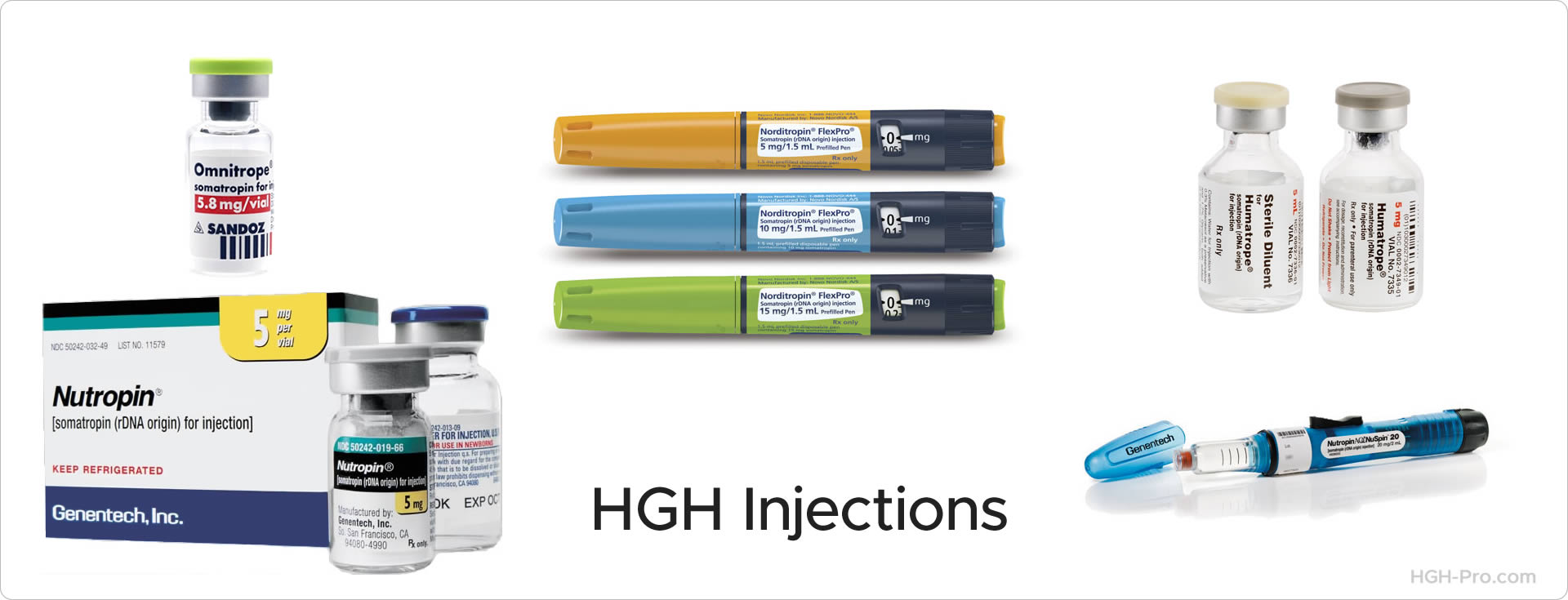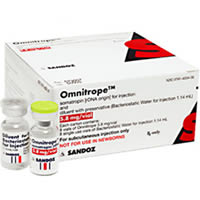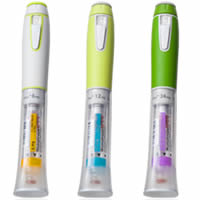HGH Injections Information, Dosages, and Risks
By Lisa Wells, RN

The human growth hormone (HGH or GH) made naturally by the pituitary gland in the brain is called somatotropin. The HGH contained in the injections is of recombinant (rDNA) origin and the generic name is Somatropin.
Somatropin is one of the most expensive drugs with a cost that usually ranges between $800 and $3,000 per month, with high quality U.S. brands such as Eli Lilly's Humatrope, Genentech's Nutropin, and Pfizer's Genotropin, as well as name brands such as Norditropin and Omnitrope usually costing more than brands and generics obtained from China and some other countries.
 Some brands come in vials that contain a powder which must be reconstituted with bacteriostatic water prior to use. The vial must then be refrigerated and remains stable for only a short time after reconstitution.
Some brands come in vials that contain a powder which must be reconstituted with bacteriostatic water prior to use. The vial must then be refrigerated and remains stable for only a short time after reconstitution.
There are also convenient and easy to use HGH pens that are already mixed and ready to use. Most require refrigeration..
Somatropin is approved for use in children with growth deficiency and in adults with muscle wasting and somatopause. In order for adults to qualify for injection therapy their IGF-1 (insulin-like growth factor 1) levels must fall below the level that is considered normal for age according to mainstream Western medicine. Some anti-aging physicians will prescribe the HGH injections to adults whose IGF-1 level may be within the normal range for their age but is not optimal for their body to function at its best.
A prescription from a medical doctor is always required.
The Risks and Possible Side Effects of HGH Injections
Human growth hormone is not an anabolic steroid but has some similar effects on the body. The HGH injections are popular among bodybuilders and athletes trying to build muscle, strength, and/or endurance. Some abuse somatropin as they abused anabolic steroids.
HGH injections can cause side effects such as acromegaly, fluid retention, enlarged breasts in males, painful joints, carpal tunnel syndrome, and liver damage when taken improperly.
Since some clinical studies have shown that hormone replacement with some other synthetically made hormones has caused an increased risk of cancer there continues to be concern about whether growth hormone might increase the risks of cancer also.
Those who take injectable GH when they do not have a deficiency may experience these side effects and risks.
When under a doctor's care the growth hormone and/or IGF-1 blood levels are monitored, which decreases the risks of side effects or the stimulation of aberrant cell growth.
Also, the patient should understand that the injections may cause their pituitary gland to become lazy because it will no longer need to release its own growth hormone. Although the injections should be cycled and slowly weaned off to try to prevent a rebound effect, the benefits may not be sustainable once the therapy stops.
Low Dose High Frequency Doses Provided Benefits Without Side Effects
Clinical studies suggest that benefits may be obtained while lowering the risks of side effects by giving smaller and more frequent doses of growth hormone.
The amount of HGH used by Dr. Daniel Rudman in his 1990 clinical study, 16.5 IU (5.33 mg) divided into three doses per week, provided substantial benefits to his test subjects. However, his dosing regimen was considered not optimal due to the side effects his patients experienced.1
Dr. Chein and Dr. Terry, in their very successful clinical study, used growth hormone doses of 4 IU to 8 IU (1.33 mg to 2.67 mg) per week divided into two subcutaneous doses per day for six days a week. The first dose was taken upon arising in the morning and the second was taken at bedtime.2
The proper dose should be prescribed individually depending on the age and condition of the patient. Some physicians will begin with low doses such as 0.5 IU per day and will slowly increase the patient's dosage in 0.5 IU monthly increments as needed based on their IGF-1 blood level.
It should be noted that usually the older the patient the more sensitive they may be, so older patients may require a smaller dose than younger patients.
Some specialists believe that Somatropin doses of over 0.1 mg per kilogram of body weight per day may likely cause side effects.
Other Options For Increasing Growth Hormone
Despite what you may have heard, most people do not require full hormone replacement with growth hormone injections if their pituitary gland is still functioning.3
Leading physicians recommend taking non-injectable supplements to increase GH naturally and safely and the injections should only be used as a last resort. (See books written about human growth hormone). I take and recommend homeopathic forms of HGH.
More Information About Growth Hormone Injections
Are Injections the Only Effective Human Growth Hormone Therapy?
Buying HGH Injections on the Internet
Bibliography
1. Rudman, Daniel, Feller, Axel G, et al, Effects of Human Growth Hormone in Men over 60 Years Old, The New England Journal of Medicine, 1990; 323:1561-1563, DOI: 10.1056/NEJM199011293232212
2. Chein, Edmund, Clinical Experience Using a Low-Dose, High-Frequency Human Growth Hormone Treatment Regimen, Journal of Advancement in Medicine, December 1999.
3. Klatz, Ronald, Grow Young With HGH, HarperPerennial, 1997.


